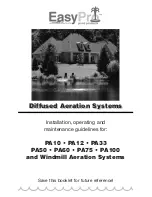
8
VII PREVENTATIVE MAINTENANCE
1. NON-CHLORINATED WATER SUPPLIES, NAK-139 BP
(as needed, based on differential
pressure).
Check the sediment prefilter (differential pressure should not exceed 15 PSI).
1) Un-plug the RO unit and turn the feedwater supply off.
2) Remove the filter cartridge from the housing, if it is not soiled, continue with this procedure.
You may have to press the red pressure relief button on the filter housing to relieve the
pressure.
3) Wash the cartridge off under the sink faucet.
4) Return the cartridge to the housing (When inserting the cartridge into the housing, be sure the
O-ring is set inside groove in the sump.)
5) Turn the water supply on and plug the RO unit in.
2. CHLORINATED WATER SUPPLIES, CAK-139 BP
(weekly)
The CAK-139 BP utilizes two activated carbon prefilters (GAC-10)
IMPORTANT:
The supply water should be checked for chlorine on a weekly basis. This is done by using
the Chlorine Test Kit (item 117) and taking a water sample after the prefilters (see test kit instructions). If
chlorine is present, the activated carbon filters must be changed. Always remember to
thoroughly flush
the new carbon filters before putting them into service. This is easily done with the sample port. (See the
SYSTEM LAYOUT
drawing)
NOTE:
Higher levels of chlorine may require a larger carbon prefilter, if one is needed, contact your local
sales representative.
3. RO PUMP
(once every month)
The clamp between the motor and pump should be checked monthly to be sure it is tight. To tighten, use
the tightening screw located on top of the pump shaft. If the clamp is allowed to become loose, the pump
shaft will wear excessively, thus voiding the pump and motor warranty.
PUMP STARVATION
1) The minimum feedwater line pressure should be 40 PSI, and the feedwater line must not
be more than 6 feet from the RO unit.
2) Air should be bled out of the prefilters by depressing the red relief button on top of the
filter with the RO pump turned off.
PUMP PRESSURE (check once a day)
If the pressure exceeds 190 PSI, excessive wear to the pump internals will occur, resulting in
a gradual loss of pressure. Keep the pressure between 130 and 190 PSI.
NOTE:
City water main pressure will tend to be higher at night. Monitor the pressure at night and adjust
the RO unit accordingly. On well pumps, check the pressure during the high cycle of the pump.
PUMP CYCLES ON AND OFF (every few seconds)
A defective pump could cause the pump to cycle rapidly on all models. Check for leaks in the
product water line. If there is a pressure tank in-line, be sure it is properly pressurized.
Summary of Contents for CAK Series
Page 12: ...12...































